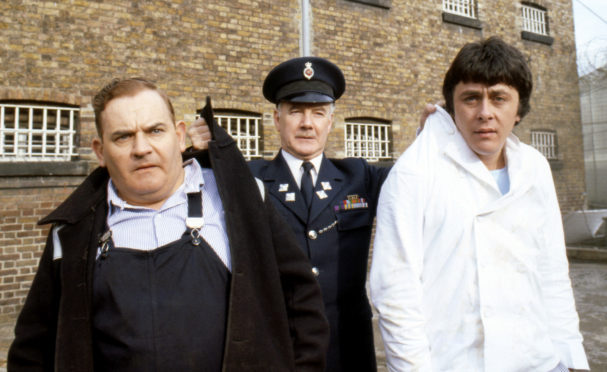How about this for a menu of the day?
Breakfast: Gruel and a slice of bread.
Dinner: Soup and bread or potatoes and bread or (if you were really lucky) a small piece of unspecified meat – yes, you’ve guessed it, with potatoes and bread
What are we talking about?
Your last in-flight meal, a budget holiday to an all-inclusive “paradise” or a cheap cruise, perhaps?
No, it’s prison food. Not now, but then.
By then I mean in Victorian times where this daily prison menu came from.
Bread was the staple – even the really bad boys could not escape it: the classic served in the punishment block was the ultimate prison dish – bread and water.
I only mention all this because NHS Grampian wants to make criminals banged up in jail physically fitter with healthier meals. The idea is that if prisoners feel better, crime rates will reduce when they get out.
Be careful what you wish for. Do we want our inmates to be so fit that they start jumping over the prison wall or outrunning the boys and girls in blue?
Would it not be better for our ne’r-do-wells to just stay as they are – overdosed on crisps, fizzy drinks and home-made drugs?
Are we handcuffed to the nanny state – locked in a padded cell lined with political correctness?
NHS Grampian has come to the not unreasonable conclusion that most criminals are an unhealthy bunch. Hannibal Lecter’s fine dining on human liver and chianti was obviously an exception rather than the rule.
Is it too much of a leap to link poor diet and health with crime?
We assume prisoners are wired up to criminal behaviour through mental defects, upbringing, peer influence and deprivation. I suspect that a well-nourished criminal would still have a healthy appetite for crime.
I wonder why we gave up serving bread and water in prison – what was wrong with it? Food is a powerful way of controlling behaviour – have you watched “I’m A Celebrity Get Me Out of Here”?
Many people think prison is a holiday camp and we have gone soft.
Look at HMP Grampian, for example. This multi-million pound modern super-prison was designed to take the penal system in Scotland into a new era by treating prisoners relatively well in nicer surroundings, for a prison that is. Presumably, the food was better too.
In no time all hell broke loose. A series of violent disorders led to the young prisoners being kicked out en-masse and found more suitable billets elsewhere in the penal system.
There was something about the new mix of inmates or the psychology of new boys getting to know each which was poisonous – with or without better food.
The moral is, you can feed tigers nice joints of beef to keep them happy, healthy and fit, but don’t turn your back or they will tear you apart.
In the old days, trying to starve prisoners was normal – even a priority on the daily list of things to do for the governor. Lack of food was accepted by the public and politically as essential to prison punishment. Starving to death in jail was not uncommon.
They don’t know they are born these days, do they?
Usually, it was bread and water – but not necessarily every day. As penal life became more “enlightened” inmates were allowed to pay to eat.
I read somewhere that bread and water punishment only disappeared from prison rules 50 years ago.
Incarceration in some hell-hole with no food can do wonders for nurturing a sense of burning injustice and creativity. Some great books have been written in prison – Cervantes, for example, who wrote Don Quixote.
I have vivid memories of reading Alexander Solzhenitsyn’s One Day in the Life of Ivan Denisovich when I was 16. It was based on the author’s harrowing experiences in a Soviet forced-labour camp in the early 1950s. In the first chapter he describes freezing prisoners sucking on fish heads and fish eyes for breakfast – leftovers from the kitchen.
There has to be a balance between punishment, rehabilitation and creature comforts in prison. Let’s be honest – how effective is rehabilitation? Do prisoners come out sneering at the do-gooders?
For some, jails are unofficial further education colleges for perfecting criminal skills of inmates to take their careers to new “heights”.
Back to the central point: can putting the right food in their bellies help their brains control criminal impulses? Maybe, but it is an uphill struggle.
Scientists are aware that a certain malfunction in a part of the brain triggers psychopathic behaviour coupled with lack of fear in criminals. They have even detected its latent presence in clinical tests on three-year-olds, which manifested itself in later life.
The interesting thing – from an NHS Grampian viewpoint – is that researchers also discovered that an intake of vitamin or mineral-enriched food could help suppress this behaviour – but not alone. It has to go hand-in-hand with improved and regular physical exercises and cognitive therapy to stand any chance of working.
But what about the often-overlooked victims of crime?
Many of these might not be able to enjoy the luxury of eating properly after physical and psychological damage inflicted on them by those relaxing at Her Majesty’s pleasure.
Perhaps we should worry more about them. I know whose side I am on.










